
前言
在AV Foundation中使用AVAudioRecorder类添加音频录制功能和使用AVAudioPlayer一样简单, 都是在Audio Queue Server上层构建的.同时支持macOS和iOS平台.可以从内置麦克风录制音频,也可以支持数字音频接口或USB外接麦克风录制.
主要内容如下:
1
2
3
4
5
6
7
8
如何创建AVAudioRecorder
1. 音频格式
2. 采样率
3. 通道数
创建Demo
1. 配置音频会话
2. 实现录音功能
3. 使用Audio Metering实现声波视觉显示
创建AVAudioRecorder之前先了解一下它的方法和成员变量
1
2
3
4
5
@property (readonly, getter=isRecording) BOOL recording;//是否正在录音
@property (readonly) NSDictionary<NSString *, id> *settings;//录音配置:采样率、音频格式、通道数...
@property (readonly) NSURL *url;//录音文件存放URL
@property (readonly) NSTimeInterval currentTime;//录音时长
@property (getter=isMeteringEnabled) BOOL meteringEnabled;//是否监控声波
AVAudioRecorder的实例方法:
1
2
3
4
5
6
7
8
9
- (BOOL)prepareToRecord;//为录音准备缓冲区
- (BOOL)record;//录音开始,暂停后调用会恢复录音
- (BOOL)recordAtTime:(NSTimeInterval)time;//在指定时间后开始录音
- (BOOL)recordForDuration:(NSTimeInterval) duration;//按指定时长录音
- (BOOL)recordAtTime:(NSTimeInterval)time
forDuration:(NSTimeInterval)duration;//上面2个的合体
- (void)pause; //暂停录音
- (void)stop; //停止录音
- (BOOL)deleteRecording;//删除录音,必须先停止录音再删除
AVAudioRecorder的代理方法:
1
2
3
4
5
6
//录音完成后调用
- (void)audioRecorderDidFinishRecording:(AVAudioRecorder *)recorder
successfully:(BOOL)flag;
//录音编码发生错误时调用
- (void)audioRecorderEncodeErrorDidOccur:(AVAudioRecorder *)recorder
error:(NSError *)error;
如何创建AVAudioRecorder
创建AVAudioRecorder对象所需要的参数如下:
- 音频流录制时写入到本地的路径URL
settings录音配置:采样率、音频格式、通道数…等键值参数字典- 发生错误的
NSError指针
如下代码:
1
2
3
4
5
6
7
8
9
10
11
12
13
14
15
16
17
18
19
20
21
/**
创建录音器
*/
- (void)createRecorder {
NSString *directory = NSTemporaryDirectory();
NSString *filePath = [directory stringByAppendingPathComponent:@"voice1.m4a"];
NSURL *url = [NSURL fileURLWithPath:filePath];
NSDictionary *setting = @{AVFormatIDKey : @(kAudioFormatMPEG4AAC),
AVSampleRateKey: @22050.0f,
AVNumberOfChannelsKey: @1};
NSError *error;
self.recorder = [[AVAudioRecorder alloc] initWithURL:url
settings:setting
error:&error];
if (self.recorder) {
[self.recorder prepareToRecord];
} else {
NSLog(@"Recorder Create Error: %@", [error localizedDescription]);
}
}
这里的建议调用[self.recorder prepareToRecord]方法对录音实例进行预设就像上一章创建AVAudioPlayer类似.都是为了执行底层Audio Queue初始化的必要过程.这个prepareToRecord方法还在给定的URL参数指定的位置创建一个文件,这样就减少了录制启动时的延时
音频格式
AVFormatIDKeykey指定录制格式,这里的除了kAudioFormatMPEG4AAC格式还有下面这些:
1
2
3
4
5
6
7
8
9
10
11
12
13
14
15
16
17
18
19
20
21
22
23
24
25
26
27
28
29
30
31
32
33
34
35
36
37
38
39
40
41
CF_ENUM(AudioFormatID)
{
kAudioFormatLinearPCM = 'lpcm',
kAudioFormatAC3 = 'ac-3',
kAudioFormat60958AC3 = 'cac3',
kAudioFormatAppleIMA4 = 'ima4',
kAudioFormatMPEG4AAC = 'aac ',
kAudioFormatMPEG4CELP = 'celp',
kAudioFormatMPEG4HVXC = 'hvxc',
kAudioFormatMPEG4TwinVQ = 'twvq',
kAudioFormatMACE3 = 'MAC3',
kAudioFormatMACE6 = 'MAC6',
kAudioFormatULaw = 'ulaw',
kAudioFormatALaw = 'alaw',
kAudioFormatQDesign = 'QDMC',
kAudioFormatQDesign2 = 'QDM2',
kAudioFormatQUALCOMM = 'Qclp',
kAudioFormatMPEGLayer1 = '.mp1',
kAudioFormatMPEGLayer2 = '.mp2',
kAudioFormatMPEGLayer3 = '.mp3',
kAudioFormatTimeCode = 'time',
kAudioFormatMIDIStream = 'midi',
kAudioFormatParameterValueStream = 'apvs',
kAudioFormatAppleLossless = 'alac',
kAudioFormatMPEG4AAC_HE = 'aach',
kAudioFormatMPEG4AAC_LD = 'aacl',
kAudioFormatMPEG4AAC_ELD = 'aace',
kAudioFormatMPEG4AAC_ELD_SBR = 'aacf',
kAudioFormatMPEG4AAC_ELD_V2 = 'aacg',
kAudioFormatMPEG4AAC_HE_V2 = 'aacp',
kAudioFormatMPEG4AAC_Spatial = 'aacs',
kAudioFormatAMR = 'samr',
kAudioFormatAMR_WB = 'sawb',
kAudioFormatAudible = 'AUDB',
kAudioFormatiLBC = 'ilbc',
kAudioFormatDVIIntelIMA = 0x6D730011,
kAudioFormatMicrosoftGSM = 0x6D730031,
kAudioFormatAES3 = 'aes3',
kAudioFormatEnhancedAC3 = 'ec-3'
};
这里的kAudioFormatLinearPCM会将为压缩的音频流写入到文件中,这就是原始数据,保真度最高,当然文件也最大, 选择ACCkAudioFormatMPEG4AAC或者AppleIMA4kAudioFormatAppleLossless等格式会显著缩小文件,还能保证音频质量.
注意: 指定的音频格式一定要和文件写入的URL文件类型保持一致。如果录制xxx.wav文件格式 是 Waveform Audio File Format(WAVE)的格式要求,即 低字节序、 LinePCM。 如果
AVFormatIDKey指定的值不是kAudioFormatLinearPCM则会发生错误。NSError 会返回如下错误 The operation couldn’t be completed. (OSState error 1718449215.)
采样率
上边的代码里AVSampleRateKey用于定义录音器的采样率. 采样率定义了对输入的模拟音频信号每一秒内的采样数. 如果使用低采样率 比如8kHz,会导致粗粒度、AM广播类型的录制效果, 不过文件会比较小; 使用44.1kHz的采样率(CD质量的采样率)会得到非常高质量的内容, 不过文件比较大. 至于使用什么样的采样率没有明确的定义. 不过开发者应该尽量使用标准的采样率,比如: 8000Hz、16 000Hz(16kHz)、22050Hz(22.05kHz)或 44100Hz(44.1kHz)、当然还有48000Hz和96000Hz ,(kHz代表千赫),超过48000或96000的采样对人耳已经没有意义.最终是我们的耳朵在进行判断.(上一章说了 人耳所能听到的声音,最低的频率是从20Hz起一直到最高频率20kHz,录音最好采用 x 2 倍的频率)
通道数
AVNumberOfChannelsKey用于定义记录音频内容的通道数。指定默认值1 意味着使用单声道录制、设置2意味着使用立体声录制。除非使用外部硬件进行录制,否则同窗应该创建单声道录音。 这里的通道数是指 录制设备的输入数量 可以理解为 麦克风 内置 或者外接麦克风录制比如 插入Apple耳机 里面的麦克风。
以上是全面
AVAudioRecorder的部分概念,AVAudioRecorder支持无限时长录制,还可以设置从未来某一时间点开始录制或指定时长录制
网络流媒体处理
AVAudioPlayer音频播放器只能播放本地文件,并且是一次性加载所有的音频数据,但我们有时候需要边下载边听怎么办? AVAudioPlayer是不支持这种网络流媒体形式的音频播放,要播放这种网络流媒体,我们需要使用AudioToolbox框架的音频队列服务Audio Queue Services。
音频队列服务分为3个部分:
- 3个缓冲器
- 1个缓冲队列
- 1个回调
1. 下面是录音的音频队列服务的工作原理:
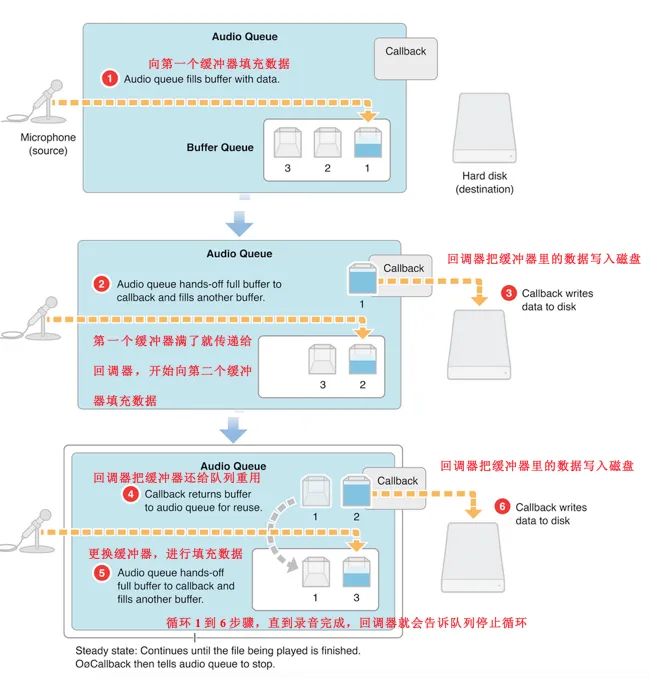
2. 下面是播放音频的音频队列服务的工作原理;
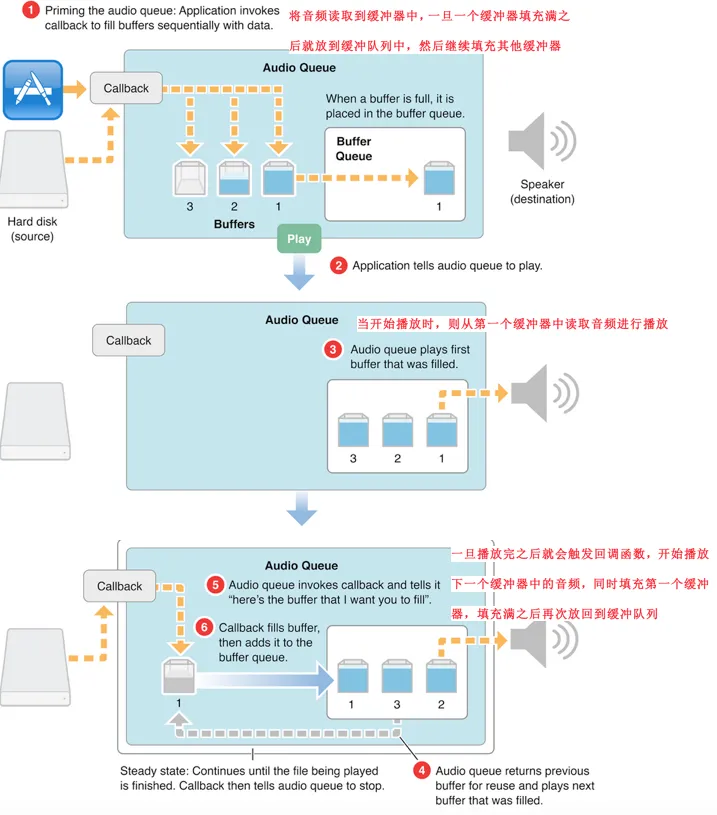
当然处理这些不需要我们自己去写C语言函数实现 有个开源库FreeStreamer
FreeStreamer使用
1
2
3
4
5
6
7
8
9
10
11
12
13
14
15
16
17
18
19
20
21
22
23
24
#import <FreeStreamer/FreeStreamer.h>
- (void)viewDidLoad {
[super viewDidLoad];
[self initAudioStream];
//播放网络流媒体音频
[self.audioStream play];
}
/* 初始化网络流媒体对象 */
- (void)initAudioStream{
NSString *urlStr = @"http://sc1.111ttt.com/2016/1/02/24/195242042236.mp3";
NSURL *url = [NSURL URLWithString:urlStr];
//创建FSAudioStream对象
self.audioStream = [[FSAudioStream alloc] initWithUrl:url];
//设置播放错误回调Block
self.audioStream.onFailure = ^(FSAudioStreamError error, NSString *description){
NSLog(@"播放过程中发生错误,错误信息:%@",description);
};
//设置播放完成回调Block
self.audioStream.onCompletion = ^(){
NSLog(@"播放完成!");
};
[self.audioStream setVolume:0.5];//设置声音大小
}
有点跑远了 回到正题 本章将不会把这个写到demo中 请谅解
下面我们来写个AVAudioRecorder的Demo 完成上述功能
配置会话
首先创建以一个AVAudioRecorderDemo工程iOS平台这些相信大家非常熟练了.
在AppDelegate里面导入#import <AVFoundation/AVFoundation.h> 写上设置如下代码
1
2
3
4
5
6
7
8
9
10
11
12
13
14
15
- (BOOL)application:(UIApplication *)application didFinishLaunchingWithOptions:(NSDictionary *)launchOptions {
AVAudioSession *session = [AVAudioSession sharedInstance];
NSError *error;
if (![session setCategory:AVAudioSessionCategoryPlayAndRecord error:&error]) {
NSLog(@"Category Error: %@",[error localizedDescription]);
}
//激活会话
if (![session setActive:YES error:&error]) {
NSLog(@"Activation Error: %@",[error localizedDescription]);
}
return YES;
}
这AVAudioSessionCategoryPlayAndRecord是上一章说的那几种Category,我们需要__录音+播放__功能
下一步 配置 plist文件访问权限信息 可以参考Access privacy-sensitive data这篇文章把访问权限需要的 信息填充上.
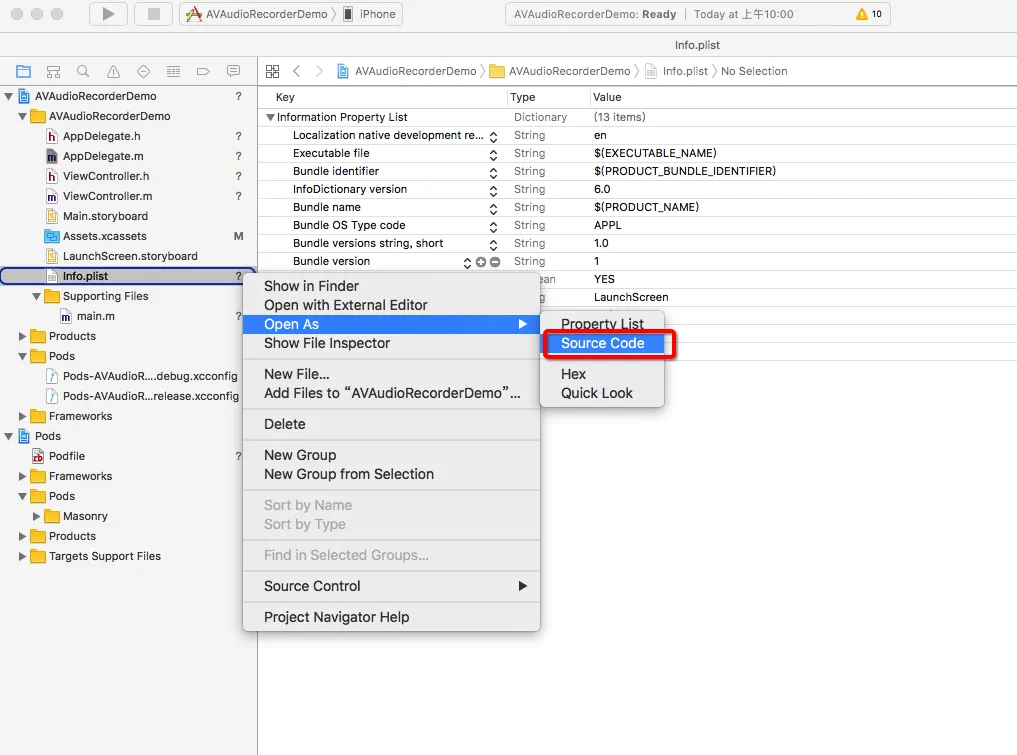
然后选择SourceCode 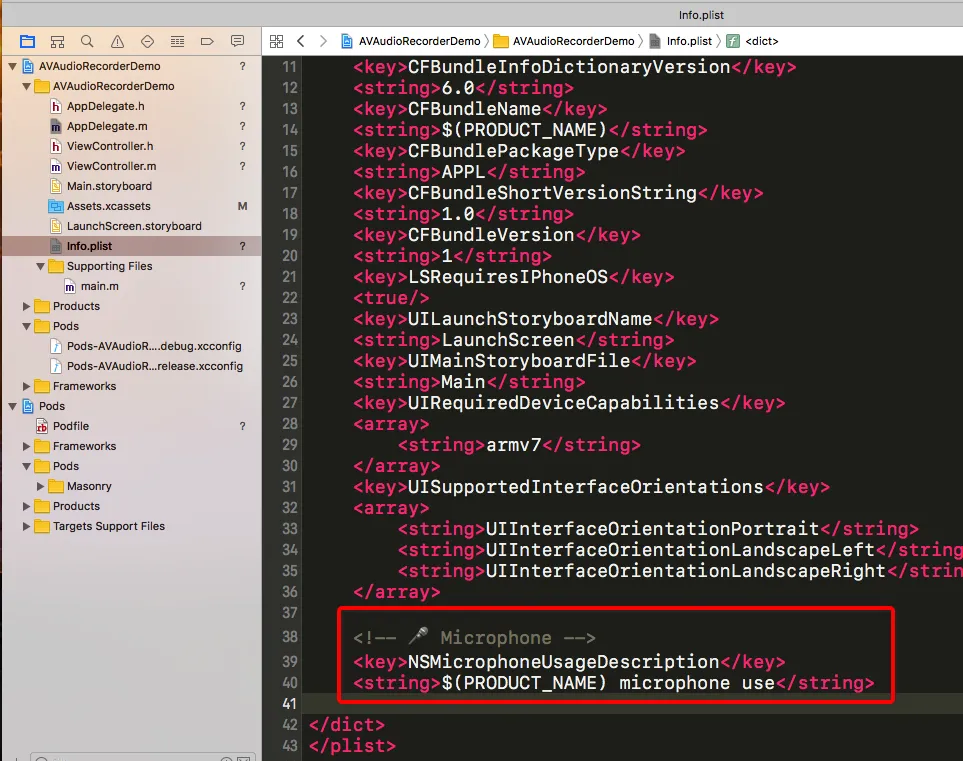
填写上
1
2
3
<!-- 🎤 Microphone -->
<key>NSMicrophoneUsageDescription</key>
<string>$(PRODUCT_NAME) microphone use</string>
上边这些是为了访问本地授权, 记得授权如果第一次被拒就必须让用户手动 到通用-设置里面去配置否则将永远不好使哈。如果不写这种本地授权 程序应该会 crash
录音代码实现
首先我们来封装一个类起名叫BDRecoder吧. 这里类我们让它负责所有 音频录制、暂停录制、保存录制文件等功能 并有回调函数等block. BDRecoder.h看起来像下面这样, 这里后续完善的话可以加个代理 表示录制过程中意外中断或者线路切换等逻辑.
1
2
3
4
5
6
7
8
9
10
11
12
13
14
15
16
17
18
19
20
21
22
23
24
25
26
27
28
29
30
31
32
33
34
35
36
37
38
39
40
41
42
43
//
// BDRecorder.h
// AVAudioRecorderDemo
//
// Created by sunyazhou on 2017/3/29.
// Copyright © 2017年 Baidu, Inc. All rights reserved.
//
#import <Foundation/Foundation.h>
#import <AVFoundation/AVFoundation.h>
@class MemoModel;
//录音停止的回调
typedef void (^BDRecordingStopCompletionHanlder)(BOOL);
//保存录音文件完成的回调
typedef void (^BDRecordingSaveCompletionHanlder)(BOOL, id);
@interface BDRecorder : NSObject
/**
* 外部获取当前录制的时间
* 小时:分钟:秒 当然后续可以加微秒和毫秒哈就是格式字符串 00:03:02 这样
*/
@property (nonatomic, readonly) NSString *formattedCurrentTime;
- (BOOL)record; //开始录音
- (void)pause; //暂停录音
- (void)stopWithCompletionHandler:(BDRecordingStopCompletionHanlder)handler;
- (void)saveRecordingWithName:(NSString *)name
completionHandler:(BDRecordingSaveCompletionHanlder)handler;
/**
回放录制的文件
@param memo 备忘录文件model 放着当前播放的model
@return 是否播放成功
*/
- (BOOL)playbackURL:(MemoModel *)memo;
@end
BDRecoder.m
1
2
3
4
5
6
7
8
9
10
11
12
13
14
15
16
17
18
19
20
21
22
23
24
25
26
27
28
29
30
31
32
33
34
35
36
37
38
39
40
41
42
43
44
45
46
47
48
49
50
51
52
53
54
55
56
57
58
59
60
61
62
63
64
65
66
67
68
69
70
71
72
73
74
75
76
77
78
79
80
81
82
83
84
85
86
87
88
89
90
//
// BDRecorder.m
// AVAudioRecorderDemo
//
// Created by sunyazhou on 2017/3/29.
// Copyright © 2017年 Baidu, Inc. All rights reserved.
//
#import "BDRecorder.h"
#import "MemoModel.h"
@interface BDRecorder () <AVAudioRecorderDelegate>
@property (nonatomic, strong) AVAudioPlayer *player;
@property (nonatomic, strong) AVAudioRecorder *recorder;
@property (nonatomic, strong) BDRecordingStopCompletionHanlder completionHandler;
@end
@implementation BDRecorder
- (instancetype)init {
self = [super init];
if (self) {
NSString *temDir = NSTemporaryDirectory();
NSString *filePath = [temDir stringByAppendingPathComponent:@"test1.caf"];
NSURL *fileURL = [NSURL fileURLWithPath:filePath];
NSDictionary *setting = @{AVFormatIDKey: @(kAudioFormatAppleIMA4),
AVSampleRateKey: @44100.0f,
AVNumberOfChannelsKey: @1,
AVEncoderBitDepthHintKey: @16,
AVEncoderAudioQualityKey: @(AVAudioQualityMedium)
};
NSError *error;
self.recorder = [[AVAudioRecorder alloc] initWithURL:fileURL settings:setting error:&error];
if (self.recorder) {
self.recorder.delegate = self;
[self.recorder prepareToRecord];
} else {
NSLog(@"Create Recorder Error: %@",[error localizedDescription]);
}
}
return self;
}
- (BOOL)record {
return [self.recorder record];
}
- (void)pause {
[self.recorder pause];
}
- (void)stopWithCompletionHandler:(BDRecordingStopCompletionHanlder)handler {
self.completionHandler = handler;
[self.recorder stop];
}
- (void)saveRecordingWithName:(NSString *)name
completionHandler:(BDRecordingSaveCompletionHanlder)handler {
NSTimeInterval timestamp = [NSDate timeIntervalSinceReferenceDate];
NSString *filename = [NSString stringWithFormat:@"%@-%f.caf", name, timestamp];
NSString *docDir = [self documentsDirectory];
NSString *destPath = [docDir stringByAppendingPathComponent:filename];
NSURL *srcURL = self.recorder.url;
NSURL *destURL = [NSURL fileURLWithPath:destPath];
NSError *error;
BOOL success = [[NSFileManager defaultManager] copyItemAtURL:srcURL toURL:destURL error:&error];
if (success) {
MemoModel *model = [MemoModel memoWithTitle:name url:destURL];
handler(YES, model);
}
}
- (NSString *)documentsDirectory {
NSArray *paths = NSSearchPathForDirectoriesInDomains(NSDocumentDirectory, NSUserDomainMask, YES);
return [paths objectAtIndex:0];
}
- (void)audioRecorderDidFinishRecording:(AVAudioRecorder *)recorder
successfully:(BOOL)flag {
if (self.completionHandler) { self.completionHandler(flag); }
}
@end
这里的self.completionHandler当外部调用stopWithCompletionHandler的时候暂存一下block是为了录音完成时告诉外部通知一下以便于可以弹出一个UIAlertView去显示保存等操作
当停止录音, 进入语音备忘阶段命名阶段时 让外部调用saveRecordingWithName:completionHandler 传入文件的命名,然后我们通过self.recorder.url获取到URL并且copy到tmp里面是目录并命名
下一步要实现playbackURL: 这里面有个MemoModel参数的对象, 这个MemoModel是一个对象model放着 文件name、url…
1
2
3
4
5
6
7
8
9
10
11
12
13
#import <Foundation/Foundation.h>
@interface MemoModel : NSObject <NSCopying>
@property (copy, nonatomic, readonly) NSString *title;
@property (strong, nonatomic, readonly) NSURL *url;
@property (copy, nonatomic, readonly) NSString *dateString;
@property (copy, nonatomic, readonly) NSString *timeString;
+ (instancetype)memoWithTitle:(NSString *)title url:(NSURL *)url;
- (BOOL)deleteMemo;
@end
//具体实现请参考我的最终demo
实现播放部分需要创建播放器 这里就简单创建一下AVAudioPlayer
1
2
3
4
5
6
7
8
9
10
11
12
13
14
15
/**
回放录制的文件
@param memo 备忘录文件model 放着当前播放的model
@return 是否播放成功
*/
- (BOOL)playbackURL:(MemoModel *)memo {
[self.player stop];
self.player = [[AVAudioPlayer alloc] initWithContentsOfURL:memo.url error:nil];
if (self.player) {
[self.player prepareToPlay];
return YES;
}
return NO;
}
这里通过memo.url 给当前播放器播放, 这里就简单实现一下 如果需要复杂实现可以参考我上一章讲解的AVAudioPlayer
最后把显示事件部分的代码加上
1
2
3
4
5
6
/**
* 外部获取当前录制的时间
* 小时:分钟:秒 当然后续可以加微秒和毫秒哈就是格式字符串 00:03:02 这样
*/
@property (nonatomic, readonly) NSString *formattedCurrentTime;
这里我们需要复写formattedCurrentTimeget方法获取时间格式例如: 00:00:00
1
2
3
4
5
6
7
8
9
10
11
12
13
14
/**
返回当前录制的时间格式 HH:mm:ss
@return 返回组装好的字符串
*/
- (NSString *)formattedCurrentTime {
NSUInteger time = (NSUInteger)self.recorder.currentTime;
NSInteger hours = (time / 3600);
NSInteger minutes = (time / 60) % 60;
NSInteger seconds = time % 60;
NSString *format = @"%02i:%02i:%02i";
return [NSString stringWithFormat:format, hours, minutes, seconds];
}
上边大致是封装BDRecorder的过程
下面是对ViewControllerUI的设置, 设置好时间格式 我们需要在ViewController里 自己搞个定时器去更新录制的时间在UI上的显示, 因为self.recorder.currentTime是只读熟悉 没提供set方法 所以我们也无法用KVO监听recorder的属性变化.
代码如下:
1
2
3
4
5
6
7
8
9
10
11
12
13
14
15
16
17
18
19
20
21
22
23
24
25
26
27
28
29
30
31
32
33
34
35
36
37
38
39
40
41
42
43
44
45
46
47
48
49
50
51
52
53
54
55
56
57
58
59
60
61
62
63
64
65
66
67
68
69
70
71
72
73
74
75
76
77
78
79
80
81
82
83
84
85
86
87
88
89
90
91
92
93
94
95
96
97
98
99
100
101
102
103
104
105
106
107
108
109
110
111
112
113
114
115
116
117
118
119
120
121
122
123
124
125
126
127
128
129
130
131
132
133
134
135
136
137
138
139
140
141
142
143
144
145
146
147
148
149
150
151
152
153
154
155
156
157
158
159
160
161
162
163
164
165
166
167
168
169
170
171
172
173
174
175
176
177
178
179
180
181
182
183
184
185
186
187
188
189
190
191
192
193
194
195
196
197
198
199
200
201
202
203
204
205
206
207
208
209
210
211
212
213
214
215
216
217
218
219
220
221
222
223
224
225
226
227
228
229
230
231
232
233
234
235
236
237
238
239
240
241
242
243
244
245
246
247
248
249
250
251
252
253
254
255
256
257
258
259
260
261
262
263
264
265
266
267
268
269
270
271
272
273
//
// ViewController.m
// AVAudioRecorderDemo
//
// Created by sunyazhou on 2017/3/28.
// Copyright © 2017年 Baidu, Inc. All rights reserved.
//
#import "ViewController.h"
#import <Masonry/Masonry.h>
#import <AVFoundation/AVFoundation.h>
#import "BDRecorder.h"
#import "LevelMeterView.h"
#import "MemoModel.h"
#import "MemoCell.h"
#import "LevelPair.h"
#define MEMOS_ARCHIVE @"memos.archive"
@interface ViewController () <UITableViewDelegate, UITableViewDataSource>
@property (nonatomic, strong) NSMutableArray <MemoModel *>*memos;
@property (nonatomic, strong) BDRecorder *recorder;
@property (nonatomic, strong) NSTimer *timer;
@property (nonatomic, strong) CADisplayLink *levelTimer;
@property (weak, nonatomic) IBOutlet UIView *containerView;
@property (weak, nonatomic) IBOutlet UIButton *recordButton;
@property (weak, nonatomic) IBOutlet UIButton *stopButton;
@property (weak, nonatomic) IBOutlet UILabel *timeLabel;
@property (weak, nonatomic) IBOutlet LevelMeterView *levelMeterView;
@property (weak, nonatomic) IBOutlet UITableView *tableview;
@end
@implementation ViewController
- (void)viewDidLoad {
[super viewDidLoad];
self.recorder = [[BDRecorder alloc] init];
self.memos = [NSMutableArray array];
self.stopButton.enabled = NO;
UIImage *recordImage = [[UIImage imageNamed:@"record"] imageWithRenderingMode:UIImageRenderingModeAlwaysOriginal];
UIImage *pauseImage = [[UIImage imageNamed:@"pause"] imageWithRenderingMode:UIImageRenderingModeAlwaysOriginal];
UIImage *stopImage = [[UIImage imageNamed:@"stop"] imageWithRenderingMode:UIImageRenderingModeAlwaysOriginal];
[self.recordButton setImage:recordImage forState:UIControlStateNormal];
[self.recordButton setImage:pauseImage forState:UIControlStateSelected];
[self.stopButton setImage:stopImage forState:UIControlStateNormal];
NSData *data = [NSData dataWithContentsOfURL:[self archiveURL]];
if (!data) {
_memos = [NSMutableArray array];
} else {
_memos = [NSKeyedUnarchiver unarchiveObjectWithData:data];
}
[self.tableview registerNib:[UINib nibWithNibName:@"MemoCell" bundle:[NSBundle mainBundle]] forCellReuseIdentifier:@"MemoCell"];
[self layoutSubveiws];
}
- (void)layoutSubveiws{
[self.containerView mas_makeConstraints:^(MASConstraintMaker *make) {
make.top.equalTo(self.view.mas_top).offset(30);
make.left.equalTo(self.view.mas_left).offset(20);
make.right.equalTo(self.view.mas_right).offset(-20);
make.centerX.equalTo(self.view.mas_centerX);
make.bottom.equalTo(self.tableview.mas_top).offset(-50);
}];
[self.tableview mas_makeConstraints:^(MASConstraintMaker *make) {
make.left.right.bottom.equalTo(self.view);
make.top.equalTo(self.view.mas_top).offset(200);
}];
[self.timeLabel mas_makeConstraints:^(MASConstraintMaker *make) {
make.top.left.right.equalTo(self.containerView);
make.centerX.equalTo(self.containerView.mas_centerX);
make.height.equalTo(@25);
}];
[self.recordButton mas_makeConstraints:^(MASConstraintMaker *make) {
make.left.equalTo(self.containerView.mas_left);
make.bottom.equalTo(self.containerView.mas_bottom);
make.width.height.equalTo(@71);
}];
[self.stopButton mas_makeConstraints:^(MASConstraintMaker *make) {
make.right.equalTo(self.containerView.mas_right);
make.bottom.equalTo(self.containerView.mas_bottom);
make.width.height.equalTo(@71);
}];
[self.levelMeterView mas_makeConstraints:^(MASConstraintMaker *make) {
make.left.right.equalTo(self.view);
make.height.equalTo(@30);
make.bottom.equalTo(self.tableview.mas_top);
}];
}
- (void)startTimer {
[self.timer invalidate];
self.timer = [NSTimer timerWithTimeInterval:0.5
target:self
selector:@selector(updateTimeDisplay)
userInfo:nil
repeats:YES];
[[NSRunLoop mainRunLoop] addTimer:self.timer forMode:NSRunLoopCommonModes];
}
- (void)stopTimer {
[self.timer invalidate];
self.timer = nil;
}
- (void)updateTimeDisplay {
self.timeLabel.text = self.recorder.formattedCurrentTime;
}
- (void)startMeterTimer {
[self.levelTimer invalidate];
self.levelTimer = [CADisplayLink displayLinkWithTarget:self selector:@selector(updateMeter)];
// if ([self.levelTimer respondsToSelector:@selector(setPreferredFramesPerSecond:)]) {
// self.levelTimer.preferredFramesPerSecond = 5;
// } else {
self.levelTimer.frameInterval = 5;
// }
[self.levelTimer addToRunLoop:[NSRunLoop currentRunLoop]
forMode:NSRunLoopCommonModes];
}
- (void)stopMeterTimer {
[self.levelTimer invalidate];
self.levelTimer = nil;
[self.levelMeterView resetLevelMeter];
}
- (void)updateMeter {
LevelPair *levels = [self.recorder levels];
self.levelMeterView.level = levels.level;
self.levelMeterView.peakLevel = levels.peakLevel;
[self.levelMeterView setNeedsDisplay];
}
#pragma mark -
#pragma mark - UITableViewDelegate
- (NSInteger)tableView:(UITableView *)tableView numberOfRowsInSection:(NSInteger)section {
return self.memos.count;
}
- (UITableViewCell *)tableView:(UITableView *)tableView cellForRowAtIndexPath:(NSIndexPath *)indexPath {
MemoCell *cell = [tableView dequeueReusableCellWithIdentifier:@"MemoCell"];
cell.model = self.memos[indexPath.row];
return cell;
}
- (void)tableView:(UITableView *)tableView didSelectRowAtIndexPath:(NSIndexPath *)indexPath{
MemoModel *model = self.memos[indexPath.row];
[self.recorder playbackURL:model];
}
- (BOOL)tableView:(UITableView *)tableView canEditRowAtIndexPath:(NSIndexPath *)indexPath {
return YES;
}
- (void)tableView:(UITableView *)tableView commitEditingStyle:(UITableViewCellEditingStyle)editingStyle forRowAtIndexPath:(NSIndexPath *)indexPath {
if (editingStyle == UITableViewCellEditingStyleDelete) {
MemoModel *memo = self.memos[indexPath.row];
[memo deleteMemo];
[self.memos removeObjectAtIndex:indexPath.row];
[self saveMemos];
[tableView deleteRowsAtIndexPaths:@[indexPath] withRowAnimation:UITableViewRowAnimationAutomatic];
}
}
- (CGFloat)tableView:(UITableView *)tableView heightForRowAtIndexPath:(NSIndexPath *)indexPath {
return 80;
}
#pragma mark - event response 所有触发的事件响应 按钮、通知、分段控件等
- (IBAction)record:(UIButton *)sender {
self.stopButton.enabled = YES;
if ([sender isSelected]) {
[self stopMeterTimer];
[self stopTimer];
[self.recorder pause];
} else {
[self startMeterTimer];
[self startTimer];
[self.recorder record];
}
[sender setSelected:![sender isSelected]];
}
- (IBAction)stopRecording:(UIButton *)sender {
[self stopMeterTimer];
self.recordButton.selected = NO;
self.stopButton.enabled = NO;
[self.recorder stopWithCompletionHandler:^(BOOL result) {
double delayInSeconds = 0.01;
dispatch_time_t popTime = dispatch_time(DISPATCH_TIME_NOW, (int64_t) (delayInSeconds * NSEC_PER_SEC));
dispatch_after(popTime, dispatch_get_main_queue(), ^{
[self showSaveDialog];
});
}];
}
- (void)showSaveDialog {
UIAlertController *alertController = [UIAlertController alertControllerWithTitle:@"保存录音" message:@"输入名称" preferredStyle:UIAlertControllerStyleAlert];
[alertController addTextFieldWithConfigurationHandler:^(UITextField * _Nonnull textField) {
textField.placeholder = @"我的录音";
}];
UIAlertAction *cancelAction = [UIAlertAction actionWithTitle:@"Cancel" style:UIAlertActionStyleCancel handler:nil];
UIAlertAction *okAction = [UIAlertAction actionWithTitle:@"OK" style:UIAlertActionStyleDefault handler:^(UIAlertAction * _Nonnull action) {
NSString *filename = [alertController.textFields.firstObject text];
[self.recorder saveRecordingWithName:filename completionHandler:^(BOOL success, id object) {
if (success) {
[self.memos insertObject:object atIndex:0];
[self saveMemos];
[self.tableview reloadData];
} else {
NSLog(@"Error saving file: %@", [object localizedDescription]);
}
}];
}];
[alertController addAction:cancelAction];
[alertController addAction:okAction];
[self presentViewController:alertController animated:YES completion:nil];
}
#pragma mark - Memo Archiving
//保存备忘录model 这里简单用归档的方式存储一下
- (void)saveMemos {
NSData *fileData = [NSKeyedArchiver archivedDataWithRootObject:self.memos];
[fileData writeToURL:[self archiveURL] atomically:YES];
}
//存储归档的路径
- (NSURL *)archiveURL {
NSArray *paths = NSSearchPathForDirectoriesInDomains(NSDocumentDirectory, NSUserDomainMask, YES);
NSString *docsDir = [paths objectAtIndex:0];
NSString *archivePath = [docsDir stringByAppendingPathComponent:MEMOS_ARCHIVE];
return [NSURL fileURLWithPath:archivePath];
}
- (void)didReceiveMemoryWarning {
[super didReceiveMemoryWarning];
// Dispose of any resources that can be recreated.
}
@end
代码稍稍有点长 我简单说一下 大家可以参照最终的demo
1
2
3
@property (nonatomic, strong) NSMutableArray <MemoModel *>*memos;
@property (nonatomic, strong) BDRecorder *recorder;
声明一个数组 存放需要播放的model对象信息 名称 文件url、日期等
1
2
@property (nonatomic, strong) NSTimer *timer;
@property (nonatomic, strong) CADisplayLink *levelTimer;
一个timer用于 刷新录制时间 levelTimer用于刷新录制的视波图也叫Audio Metering对音频进行计量
在BDRecorder中增加了
1
2
3
4
5
6
7
8
- (LevelPair *)levels {
[self.recorder updateMeters];
float avgPower = [self.recorder averagePowerForChannel:0];
float peakPower = [self.recorder peakPowerForChannel:0];
float linearLevel = [self.meterTable valueForPower:avgPower];
float linearPeak = [self.meterTable valueForPower:peakPower];
return [LevelPair levelsWithLevel:linearLevel peakLevel:linearPeak];
}
这两个方法 1. averagePowerForChannel取出波谷平均值 2. peakPowerForChannel取出波峰 两个方法都会返回一个用于表示声音分贝(dB)等级的浮点值. 这个值的表示范围0dB(fullscale) ~ -160dB 0dB最大 -160dB最小
开启音频计量 (需要在BDRecorder中开启, 如下代码) 会带来很多额外的开销,但我觉得还是很划算的 毕竟要显示视觉效果才是王道. 如果meteringEnabled开启则音频录音器就会对捕捉到的音频样本进行分贝计算。
开启音频计量(Audio Metering)方法:
1
self.recorder.meteringEnabled = YES;
更新前调用了如下代码
1
2
3
4
- (LevelPair *)levels {
[self.recorder updateMeters];
...
}
每当读取值之前需要调用[self.recorder updateMeters]方法才能获取到最新值,否则可能获取的不够精确
然后 使用MeterTable类 声明的函数valueForPower: 把上边两个阀值 转成线性运算
就是分贝值从对数形式的-160 ~ 0范围转换为线性0到1的形式.
1
2
3
4
5
6
7
8
9
10
11
12
13
14
15
16
17
18
19
20
21
22
23
24
25
26
27
28
29
30
31
32
33
34
35
36
37
38
39
40
41
42
43
44
45
46
47
48
49
50
51
52
53
54
55
56
57
58
//
// MeterTable.m
// AVAudioRecorderDemo
//
// Created by sunyazhou on 2017/4/5.
// Copyright © 2017年 Baidu, Inc. All rights reserved.
//
#import "MeterTable.h"
#define MIN_DB -60.0f
#define TABLE_SIZE 300
@implementation MeterTable {
float _scaleFactor;
NSMutableArray *_meterTable;
}
- (id)init {
self = [super init];
if (self) {
float dbResolution = MIN_DB / (TABLE_SIZE - 1);
_meterTable = [NSMutableArray arrayWithCapacity:TABLE_SIZE];
_scaleFactor = 1.0f / dbResolution;
float minAmp = dbToAmp(MIN_DB);
float ampRange = 1.0 - minAmp;
float invAmpRange = 1.0 / ampRange;
for (int i = 0; i < TABLE_SIZE; i++) {
float decibels = i * dbResolution;
float amp = dbToAmp(decibels);
float adjAmp = (amp - minAmp) * invAmpRange;
_meterTable[i] = @(adjAmp);
}
}
return self;
}
float dbToAmp(float dB) {
return powf(10.0f, 0.05f * dB);
}
- (float)valueForPower:(float)power {
if (power < MIN_DB) {
return 0.0f;
} else if (power >= 0.0f) {
return 1.0f;
} else {
int index = (int) (power * _scaleFactor);
return [_meterTable[index] floatValue];
}
}
@end
这个类创建了一个数组
_meterTable保存从计算前的分贝数到使用一定级别分贝解析之后的转换结果, 这里使用的解析率-0.2dB, 解析等级可以通过MIN_DBTABLE_SIZE这两个宏的值来修改,每个分贝值都调用dbToAmp:函数转换为线性范围内的值,使其处于0(-60dB) ~ 1()范围内, 之后由这些范围内的值构成平行曲线,开平方计算并保存到内部查找表格中. 然后如果外部需要可以调用valueForPower:来获取.
然后保存到LevelPair的实例对象返回 这个实例很简单存放两个值一个level一个peakLevel
1
2
3
4
5
6
7
8
9
@interface LevelPair : NSObject
@property (nonatomic, readonly) float level;
@property (nonatomic, readonly) float peakLevel;
+ (instancetype)levelsWithLevel:(float)level peakLevel:(float)peakLevel;
- (instancetype)initWithLevel:(float)level peakLevel:(float)peakLevel;
@end
在ViewController中显示相关的UI
1
2
3
4
5
6
7
8
9
10
11
12
13
14
15
16
17
18
19
20
21
22
23
24
25
26
27
28
29
30
31
32
33
34
35
36
37
38
39
40
41
42
43
44
45
46
47
- (void)startTimer {
[self.timer invalidate];
self.timer = [NSTimer timerWithTimeInterval:0.5
target:self
selector:@selector(updateTimeDisplay)
userInfo:nil
repeats:YES];
[[NSRunLoop mainRunLoop] addTimer:self.timer forMode:NSRunLoopCommonModes];
}
- (void)stopTimer {
[self.timer invalidate];
self.timer = nil;
}
- (void)updateTimeDisplay {
self.timeLabel.text = self.recorder.formattedCurrentTime;
}
- (void)startMeterTimer {
[self.levelTimer invalidate];
self.levelTimer = [CADisplayLink displayLinkWithTarget:self selector:@selector(updateMeter)];
// if ([self.levelTimer respondsToSelector:@selector(setPreferredFramesPerSecond:)]) {
// self.levelTimer.preferredFramesPerSecond = 5;
// } else {
self.levelTimer.frameInterval = 5;
// }
[self.levelTimer addToRunLoop:[NSRunLoop currentRunLoop]
forMode:NSRunLoopCommonModes];
}
- (void)stopMeterTimer {
[self.levelTimer invalidate];
self.levelTimer = nil;
[self.levelMeterView resetLevelMeter];
}
- (void)updateMeter {
LevelPair *levels = [self.recorder levels];
self.levelMeterView.level = levels.level;
self.levelMeterView.peakLevel = levels.peakLevel;
[self.levelMeterView setNeedsDisplay];
}
用于定时器的处理
事件的相关响应
1
2
3
4
5
6
7
8
9
10
11
12
13
14
15
16
17
18
19
20
21
22
23
24
25
26
27
28
#pragma mark - event response 所有触发的事件响应 按钮、通知、分段控件等
- (IBAction)record:(UIButton *)sender {
self.stopButton.enabled = YES;
if ([sender isSelected]) {
[self stopMeterTimer];
[self stopTimer];
[self.recorder pause];
} else {
[self startMeterTimer];
[self startTimer];
[self.recorder record];
}
[sender setSelected:![sender isSelected]];
}
- (IBAction)stopRecording:(UIButton *)sender {
[self stopMeterTimer];
self.recordButton.selected = NO;
self.stopButton.enabled = NO;
[self.recorder stopWithCompletionHandler:^(BOOL result) {
double delayInSeconds = 0.01;
dispatch_time_t popTime = dispatch_time(DISPATCH_TIME_NOW, (int64_t) (delayInSeconds * NSEC_PER_SEC));
dispatch_after(popTime, dispatch_get_main_queue(), ^{
[self showSaveDialog];
});
}];
}
这里保存数据使用的是归档方式
BDRecorder没有 处理意外中断等情况 比如外接麦克风 和音频意外来电等,如果需要处理 就可以在BDRecorder中声明几个代理监听音频回话的那几个通知就可以了 这里出于学习为目的就简单写到这里吧,如果大家需求强烈我可以回头补上并开源。
很多人纠结如何根据波形绘制更好的图 我这里是借助本书作者的demo完成相关波形处理的视图。
1
2
3
4
5
6
7
8
9
10
11
12
13
14
15
16
17
18
19
20
21
22
23
24
25
26
27
28
29
30
31
32
33
34
35
36
37
38
39
40
41
42
43
44
45
46
47
48
49
50
51
52
53
54
55
56
57
58
59
60
61
62
63
64
65
66
67
68
69
70
71
72
73
74
75
76
77
78
79
80
81
82
83
84
85
86
87
88
89
90
91
92
93
94
95
96
97
98
99
100
101
102
103
104
105
106
107
108
109
110
111
112
113
114
115
116
117
118
119
120
121
122
123
124
125
126
127
128
129
130
131
132
133
134
135
136
137
138
139
140
141
142
#import "LevelMeterView.h"
#import "LevelMeterColorThreshold.h"
@interface LevelMeterView ()
@property (nonatomic) NSUInteger ledCount;
@property (strong, nonatomic) UIColor *ledBackgroundColor;
@property (strong, nonatomic) UIColor *ledBorderColor;
@property (nonatomic, strong) NSArray *colorThresholds;
@end
@implementation LevelMeterView
- (id)initWithFrame:(CGRect)frame {
self = [super initWithFrame:frame];
if (self) {
[self setupView];
}
return self;
}
- (id)initWithCoder:(NSCoder *)coder {
self = [super initWithCoder:coder];
if (self) {
[self setupView];
}
return self;
}
- (void)setupView {
self.backgroundColor = [UIColor clearColor];
_ledCount = 20;
_ledBackgroundColor = [UIColor colorWithWhite:0.0f alpha:0.35f];
_ledBorderColor = [UIColor blackColor];
UIColor *greenColor = [UIColor colorWithRed:0.458 green:1.000 blue:0.396 alpha:1.000];
UIColor *yellowColor = [UIColor colorWithRed:1.000 green:0.930 blue:0.315 alpha:1.000];
UIColor *redColor = [UIColor colorWithRed:1.000 green:0.325 blue:0.329 alpha:1.000];
_colorThresholds = @[[LevelMeterColorThreshold colorThresholdWithMaxValue:0.5 color:greenColor name:@"green"],
[LevelMeterColorThreshold colorThresholdWithMaxValue:0.8 color:yellowColor name:@"yellow"],
[LevelMeterColorThreshold colorThresholdWithMaxValue:1.0 color:redColor name:@"red"]];
}
- (void)drawRect:(CGRect)rect {
CGContextRef context = UIGraphicsGetCurrentContext();
CGContextTranslateCTM(context, 0, CGRectGetHeight(self.bounds));
CGContextRotateCTM(context, (CGFloat) -M_PI_2);
CGRect bounds = CGRectMake(0., 0., [self bounds].size.height, [self bounds].size.width);
CGFloat lightMinValue = 0.0f;
NSInteger peakLED = -1;
if (self.peakLevel > 0.0f) {
peakLED = self.peakLevel * self.ledCount;
if (peakLED >= self.ledCount) {
peakLED = self.ledCount - 1;
}
}
for (int ledIndex = 0; ledIndex < self.ledCount; ledIndex++) {
UIColor *ledColor = [self.colorThresholds[0] color];
CGFloat ledMaxValue = (CGFloat) (ledIndex + 1) / self.ledCount;
for (int colorIndex = 0; colorIndex < self.colorThresholds.count - 1; colorIndex++) {
LevelMeterColorThreshold *currThreshold = self.colorThresholds[colorIndex];
LevelMeterColorThreshold *nextThreshold = self.colorThresholds[colorIndex + 1];
if (currThreshold.maxValue <= ledMaxValue) {
ledColor = nextThreshold.color;
}
}
CGFloat height = CGRectGetHeight(bounds);
CGFloat width = CGRectGetWidth(bounds);
CGRect ledRect = CGRectMake(0.0f, height * ((CGFloat) ledIndex / self.ledCount), width, height * (1.0f / self.ledCount));
// Fill background color
CGContextSetFillColorWithColor(context, self.ledBackgroundColor.CGColor);
CGContextFillRect(context, ledRect);
// Draw Light
CGFloat lightIntensity;
if (ledIndex == peakLED) {
lightIntensity = 1.0f;
} else {
lightIntensity = clamp((self.level - lightMinValue) / (ledMaxValue - lightMinValue));
}
UIColor *fillColor = nil;
if (lightIntensity == 1.0f) {
fillColor = ledColor;
} else if (lightIntensity > 0.0f) {
CGColorRef color = CGColorCreateCopyWithAlpha([ledColor CGColor], lightIntensity);
fillColor = [UIColor colorWithCGColor:color];
CGColorRelease(color);
}
CGContextSetFillColorWithColor(context, fillColor.CGColor);
UIBezierPath *fillPath = [UIBezierPath bezierPathWithRoundedRect:ledRect cornerRadius:2.0f];
CGContextAddPath(context, fillPath.CGPath);
// Stroke border
CGContextSetStrokeColorWithColor(context, self.ledBorderColor.CGColor);
UIBezierPath *strokePath = [UIBezierPath bezierPathWithRoundedRect:CGRectInset(ledRect, 0.5, 0.5) cornerRadius:2.0f];
CGContextAddPath(context, strokePath.CGPath);
CGContextDrawPath(context, kCGPathFillStroke);
lightMinValue = ledMaxValue;
}
}
CGFloat clamp(CGFloat intensity) {
if (intensity < 0.0f) {
return 0.0f;
} else if (intensity >= 1.0) {
return 1.0f;
} else {
return intensity;
}
}
- (void)resetLevelMeter {
self.level = 0.0f;
self.peakLevel = 0.0f;
[self setNeedsDisplay];
}
@end
这里给出了level和peak的阀值 有很多第三方开源的view大家可以自行研究一下 很简单 就是把相关阀值量化的过程。
总结
AVAudioRecorder 的学习还算完整的搞完了,随时记录一下学习内容和技术知识。
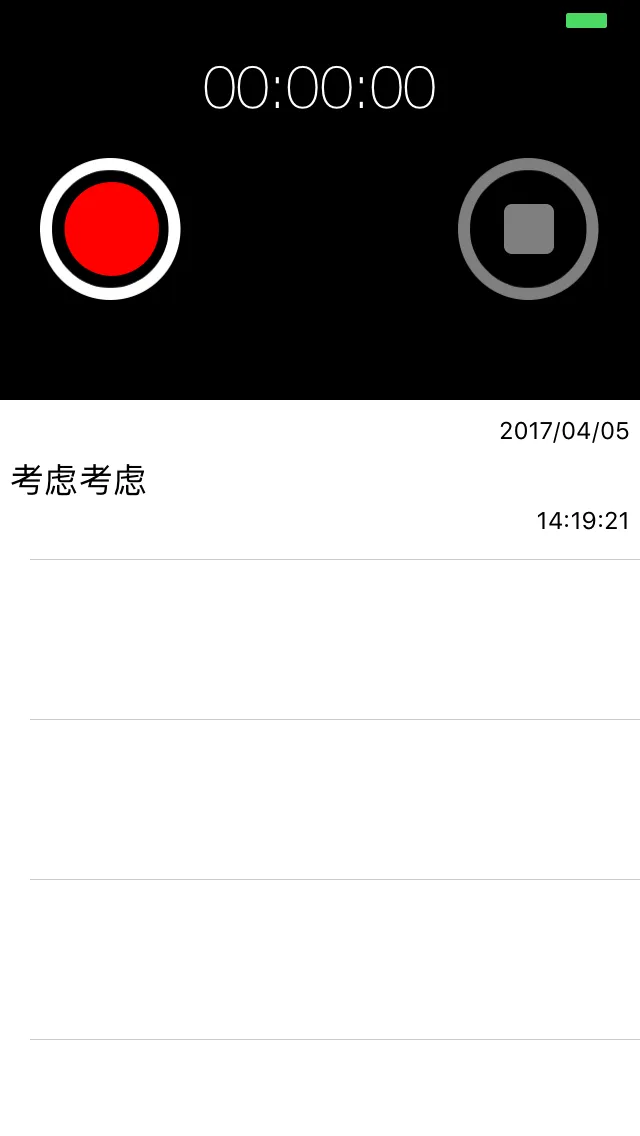
最终Demo
欢迎大家指正错误 全文完